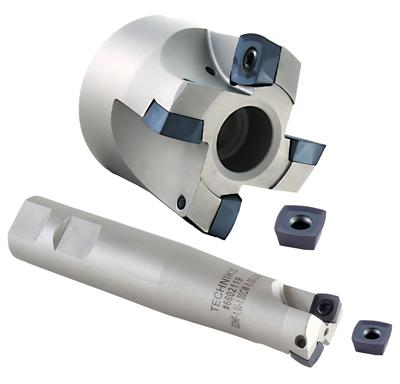
Techniks continues to add to its new cutting tool offerings with the announcement of SDHF high feed end mills and face mills. Both end mills and face mills are made from H-13 tool steel, and are nickel-coated to promote longer life and feature internal coolant directed at each cutting edge.
"This tooling, when used with our SDKX all-material inserts, achieves higher feed rates in steel, stainless steel, cast iron, hardened steel, and even high-temperature alloys without stopping to change inserts," states Mark Frost, National Sales Manager.
"In tests, we are able to increase feed rates up to 60 percent. When you consider that, in addition to faster feed rates, there is no need to change inserts for different materials. We can provide significant increases in productivity," continues Frost. "An ideal application for these high-feed cutters is helical interpolation—producing holes quickly from a solid, or enlarging existing holes. Holes can be blind with flat bottoms, or through-holes. For the end mill holders, the recommended insert is Techniks' SDKX 0904. Face mills, use the SDKX 1205 insert.
Contact Details
Related Glossary Terms
- alloys
alloys
Substances having metallic properties and being composed of two or more chemical elements of which at least one is a metal.
- coolant
coolant
Fluid that reduces temperature buildup at the tool/workpiece interface during machining. Normally takes the form of a liquid such as soluble or chemical mixtures (semisynthetic, synthetic) but can be pressurized air or other gas. Because of water’s ability to absorb great quantities of heat, it is widely used as a coolant and vehicle for various cutting compounds, with the water-to-compound ratio varying with the machining task. See cutting fluid; semisynthetic cutting fluid; soluble-oil cutting fluid; synthetic cutting fluid.
- feed
feed
Rate of change of position of the tool as a whole, relative to the workpiece while cutting.
- flat ( screw flat)
flat ( screw flat)
Flat surface machined into the shank of a cutting tool for enhanced holding of the tool.
- milling machine ( mill)
milling machine ( mill)
Runs endmills and arbor-mounted milling cutters. Features include a head with a spindle that drives the cutters; a column, knee and table that provide motion in the three Cartesian axes; and a base that supports the components and houses the cutting-fluid pump and reservoir. The work is mounted on the table and fed into the rotating cutter or endmill to accomplish the milling steps; vertical milling machines also feed endmills into the work by means of a spindle-mounted quill. Models range from small manual machines to big bed-type and duplex mills. All take one of three basic forms: vertical, horizontal or convertible horizontal/vertical. Vertical machines may be knee-type (the table is mounted on a knee that can be elevated) or bed-type (the table is securely supported and only moves horizontally). In general, horizontal machines are bigger and more powerful, while vertical machines are lighter but more versatile and easier to set up and operate.
